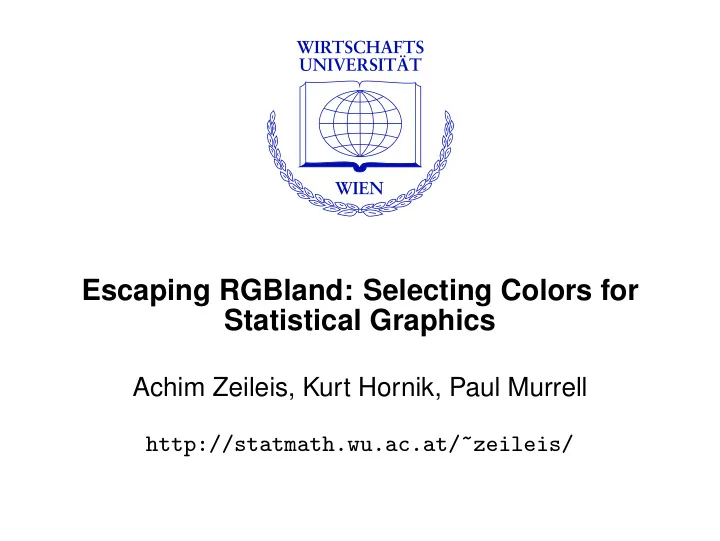

Escaping RGBland: Selecting Colors for Statistical Graphics Achim Zeileis, Kurt Hornik, Paul Murrell http://statmath.wu.ac.at/~zeileis/
Color in statistical graphics Color: Integral element in graphical displays. Easily available in statistical software. Omnipresent in (electronic) publications: technical reports, electronic journal articles, presentation slides. Problem: Little guidance about how to choose appropriate colors for a particular visualization task. Question: What are useful color palettes for coding qualitative and quantitative variables?
Challenges Basic principles: Colors should be intuitive, avoid large areas of saturated colors. Purpose: Distinguish different elements of a statistical graphic depending on the levels of some variable. Control of perceptual properties: hue, brightness, colorfulness. Employ a color model or color space . RGB (Red-Green-Blue): Corresponds to generation of colors on computer, unintuitive for humans. HSV (Hue-Saturation-Value): Simple transformation of RGB, easily available. But: Maps poorly to perceptual properties, encourages use of highly saturated colors. HCL (Hue-Chroma-Luminance): Transformation of CIELUV space, mitigates problems above. Ideally, colors should work for: Screen, projector, (grayscale) printer, color-blind viewers, . . .
Tools (in R) Basic color spaces: rgb() , hsv() , hcl() , . . . HSV-based palettes: rainbow() , heat.colors() , . . . More suitable tools: RColorBrewer (fixed palettes from ColorBrewer.org ), ggplot2 , plotrix , colorRamp() (based on RGB and CIELAB), . . . Here: colorspace with RGB() , polarLUV() , . . . , and rainbow_hcl() , heat_hcl() , sequential_hcl() , diverge_hcl() , . . . Result: Similar to ColorBrewer.org but with more flexibility and more insight into underlying ideas. Example: Heatmap of bivariate kernel density estimate for Old Faithful geyser eruptions data
Example: Heatmap
Example: Heatmap
Example: Heatmap
Example: Heatmap
Types of palettes Qualitative: Code categorical information. Examples: Barplot, mosaic display, . . . Use different hues, keeping chroma and luminance fixed: e.g., ( H , 50 , 70 ) .
Types of palettes Sequential: Code numerical information ranging from “uninteresting” to “interesting”. Increase luminance along with interestingness. Additionally increase chroma. Potentially vary hue. When interestingness i is standardized to [ 0 , 1 ] : ( H 2 − i · ( H 1 − H 2 ) , C max − i ′ · ( C max − C min ) , L max − i ′′ · ( L max − L min )) . Diverging: Code numerical information diverging from neutral value into two directions of “interestingness”. Combine two sequential palettes with different hues.
Example: Model deviations Application: Childhood mortality in Nigeria. Posterior mode estimates (without spatial effect). Map of Nigeria shaded by model deviations. Investigate typical HSV-based vs. HCL-based palette. Investigate effects of color-blindness (protanopic vision) by means of dichromat package.
Example: Model deviations
Example: Model deviations
Example: Model deviations
Example: Model deviations
Example: Model deviations
Example: Model deviations
Example: Model deviations
Example: Model deviations
Summary Use color with care, don’t overestimate power of color. Avoid large areas of flashy, highly saturated colors. Employ monotonic luminance scale for numerical data. HCL space allows for intuitive variation of perceptual properties. Formulas for palettes are easy to implemented in new software. Convenience functions (similar to base R tools) are readily provided in colorspace .
References Zeileis A, Hornik K, Murrell P (2009). “Escaping RGBland: Selecting Colors for Statistical Graphics.” Computational Statistics & Data Analysis , 53 , 3259–3270. doi:10.1016/j.csda.2008.11.033 . Zeileis A, Meyer D, Hornik K (2007). “Residual-Based Shadings for Visualizing (Conditional) Independence.” Journal of Computational and Graphical Statistics , 16 (3), 507–525. doi:10.1198/106186007X237856 . Lumley T (2006). “Color Coding and Color Blindness in Statistical Graphics.” ASA Statistical Computing & Graphics Newsletter , 17 (2), 4–7. URL http://www. amstat-online.org/sections/graphics/newsletter/Volumes/v172.pdf . Ihaka R (2003). “Colour for Presentation Graphics.” In K Hornik, F Leisch, A Zeileis (eds.), “Proceedings of the 3rd International Workshop on Distributed Statistical Computing,” Vienna, Austria, ISSN 1609-395X, URL http://www.ci.tuwien.ac.at/Conferences/DSC-2003/Proceedings/ .
Recommend
More recommend